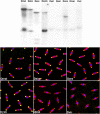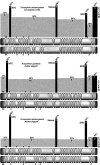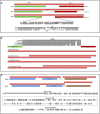Probing the boundaries of orthology: the unanticipated rapid evolution of Drosophila centrosomin
- PMID: 23749319
- PMCID: PMC3730919
- DOI: 10.1534/genetics.113.152546
Probing the boundaries of orthology: the unanticipated rapid evolution of Drosophila centrosomin
Abstract
The rapid evolution of essential developmental genes and their protein products is both intriguing and problematic. The rapid evolution of gene products with simple protein folds and a lack of well-characterized functional domains typically result in a low discovery rate of orthologous genes. Additionally, in the absence of orthologs it is difficult to study the processes and mechanisms underlying rapid evolution. In this study, we have investigated the rapid evolution of centrosomin (cnn), an essential gene encoding centrosomal protein isoforms required during syncytial development in Drosophila melanogaster. Until recently the rapid divergence of cnn made identification of orthologs difficult and questionable because Cnn violates many of the assumptions underlying models for protein evolution. To overcome these limitations, we have identified a group of insect orthologs and present conserved features likely to be required for the functions attributed to cnn in D. melanogaster. We also show that the rapid divergence of Cnn isoforms is apparently due to frequent coding sequence indels and an accelerated rate of intronic additions and eliminations. These changes appear to be buffered by multi-exon and multi-reading frame maximum potential ORFs, simple protein folds, and the splicing machinery. These buffering features also occur in other genes in Drosophila and may help prevent potentially deleterious mutations due to indels in genes with large coding exons and exon-dense regions separated by small introns. This work promises to be useful for future investigations of cnn and potentially other rapidly evolving genes and proteins.
Keywords: Cnn; Drosophila; centrosome; indels; rapid evolution.
Figures













Similar articles
-
An Amino-Terminal Polo Kinase Interaction Motif Acts in the Regulation of Centrosome Formation and Reveals a Novel Function for centrosomin (cnn) in Drosophila.Genetics. 2015 Oct;201(2):685-706. doi: 10.1534/genetics.115.181842. Genetics. 2015. PMID: 26447129 Free PMC article.
-
Large introns in relation to alternative splicing and gene evolution: a case study of Drosophila bruno-3.BMC Genet. 2009 Oct 19;10:67. doi: 10.1186/1471-2156-10-67. BMC Genet. 2009. PMID: 19840385 Free PMC article.
-
The evolution of small insertions and deletions in the coding genes of Drosophila melanogaster.Mol Biol Evol. 2013 Dec;30(12):2699-708. doi: 10.1093/molbev/mst167. Epub 2013 Sep 26. Mol Biol Evol. 2013. PMID: 24077769
-
Centrosomin: a complex mix of long and short isoforms is required for centrosome function during early development in Drosophila melanogaster.Genetics. 2009 Aug;182(4):979-97. doi: 10.1534/genetics.109.103887. Epub 2009 Jun 15. Genetics. 2009. PMID: 19528326 Free PMC article.
-
Genomic organisation of the neural sex determination gene fruitless (fru) in the Hawaiian species Drosophila silvestris and the conservation of the fru BTB protein-protein-binding domain throughout evolution.Hereditas. 2000;132(1):67-78. doi: 10.1111/j.1601-5223.2000.00067.x. Hereditas. 2000. PMID: 10857262
Cited by
-
The end of a monolith: Deconstructing the Cnn-Polo interaction.Fly (Austin). 2016 Apr 2;10(2):60-72. doi: 10.1080/19336934.2016.1178419. Epub 2016 Apr 20. Fly (Austin). 2016. PMID: 27096551 Free PMC article.
-
An Amino-Terminal Polo Kinase Interaction Motif Acts in the Regulation of Centrosome Formation and Reveals a Novel Function for centrosomin (cnn) in Drosophila.Genetics. 2015 Oct;201(2):685-706. doi: 10.1534/genetics.115.181842. Genetics. 2015. PMID: 26447129 Free PMC article.
-
The Deadbeat Paternal Effect of Uncapped Sperm Telomeres on Cell Cycle Progression and Chromosome Behavior in Drosophila melanogaster.Genetics. 2016 Jun;203(2):799-816. doi: 10.1534/genetics.115.182436. Epub 2016 Mar 30. Genetics. 2016. PMID: 27029731 Free PMC article.
-
A partial genome assembly of the miniature parasitoid wasp, Megaphragma amalphitanum.PLoS One. 2019 Dec 23;14(12):e0226485. doi: 10.1371/journal.pone.0226485. eCollection 2019. PLoS One. 2019. PMID: 31869362 Free PMC article.
-
Expression interplay of genes coding for calcium-binding proteins and transcription factors during the osmotic phase provides insights on salt stress response mechanisms in bread wheat.Plant Mol Biol. 2024 Nov 1;114(6):119. doi: 10.1007/s11103-024-01523-z. Plant Mol Biol. 2024. PMID: 39485577 Free PMC article.
References
Publication types
MeSH terms
Substances
LinkOut - more resources
Full Text Sources
Other Literature Sources
Molecular Biology Databases

